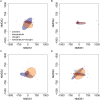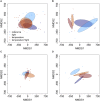Combinations of Abiotic Factors Differentially Alter Production of Plant Secondary Metabolites in Five Woody Plant Species in the Boreal-Temperate Transition Zone
- PMID: 30233611
- PMCID: PMC6134262
- DOI: 10.3389/fpls.2018.01257
Combinations of Abiotic Factors Differentially Alter Production of Plant Secondary Metabolites in Five Woody Plant Species in the Boreal-Temperate Transition Zone
Keywords: PSM diversity; balsam fir; beaked hazel; paper birch; phytochemical turnover; red maple; trembling aspen; untargeted metabolomics.
Figures







References
-
- Alexander L. V., Zhang X., Peterson T. C., Caesar J., Gleason B., Klein Tank A. M. G., et al. (2006). Global observed changes in daily climate extremes of temperature and precipitation. J. Geophys. Res. 111:D05109 10.1029/2005JD006290 - DOI
-
- Anderson M. J. (2001). A new method for non-parametric multivariate analysis of variance. Austral Ecol. 26 32–46. 10.1111/j.1442-9993.2001.01070.pp.x - DOI
LinkOut - more resources
Full Text Sources
Other Literature Sources
Miscellaneous

